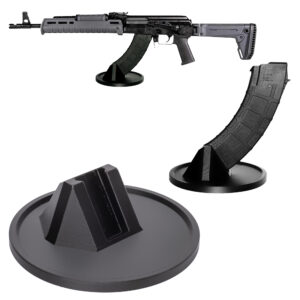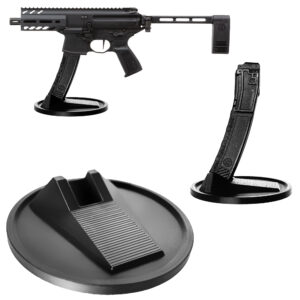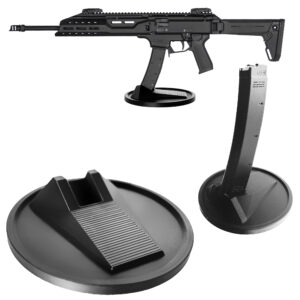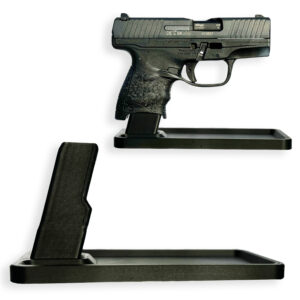Categories:
The AR-15 rifle, renowned for its modular design and widespread use, has a trigger mechanism that is both intricate and fundamental to its operation. The trigger mechanism serves as the control interface between the shooter and the gun’s firing system, playing a critical role in discharging a round. This mechanism primarily includes the trigger, hammer, sear, and disconnector, each working in concert to ensure reliable function.
When the shooter pulls the trigger, it initiates a chain of actions that culminate in the firing of a round. In the resting state, the trigger is connected to the sear, which holds the hammer in a cocked position against spring tension. As the trigger is pulled, it rotates around a pivot point and causes the sear to disengage from the hammer.
This disengagement allows the compressed hammer spring to propel the hammer forward with considerable force. The hammer then strikes the firing pin, which is situated in the bolt carrier group. The firing pin subsequently impacts the primer of the cartridge in the chamber, igniting the gunpowder and expelling the bullet through the barrel. Following this action, the bolt carrier group cycles back due to the gas operation system, which involves the redirection of a portion of the high-pressure gas from the fired cartridge.
As the bolt carrier group moves rearward, it re-cocks the hammer by pushing it back into the sear. The disconnector comes into play as the bolt cycles back. Its role is to momentarily hold the hammer as the trigger is still depressed, preventing it from following the bolt carrier forward and causing unintended discharge. When the shooter releases the trigger, the disconnector disengages, allowing the sear to catch the hammer once again.
This resets the trigger mechanism, readying it for the next round to be fired. This meticulously engineered sequence ensures that each pull of the trigger results in a single round being fired, a characteristic of semi-automatic action. The design incorporates various safety features to prevent accidental discharge, including the trigger and hammer springs, which are essential for proper function and longevity.
The components of the AR-15 trigger system play crucial roles in ensuring the gun operates safely and efficiently. Understanding these components provides insight into the mechanics behind the trigger pull and the subsequent release of the hammer that fires a round. At the heart of the system lies the trigger itself, a simple yet vital lever that the operator pulls to initiate the firing sequence.
The trigger is connected to the lower receiver of the gun, where it interacts with several other key components. One of these components is the disconnector, a small but essential part that ensures semi-automatic firing, preventing the gun from shooting more than one round with a single trigger pull. When the trigger is pulled, the disconnector temporarily holds the hammer in a cocked position until the trigger is released, at which point the hammer is allowed to strike the firing pin.
This action propels the firing pin forward to ignite the primer of the cartridge, leading to the discharge of the round. The hammer is another crucial element. Positioned in a readiness state within the lower receiver, the hammer is driven by the force of the hammer spring. Upon the trigger’s release, the hammer swings forward with considerable force to impact the firing pin.
The firing pin, in turn, strikes the primer of the loaded cartridge, initiating the chain reaction that results in a fired round. The trigger spring and hammer spring are also fundamental to the trigger mechanism. These springs provide the necessary tension for the trigger and hammer to function correctly. The trigger spring returns the trigger to its initial position after being pulled, while the hammer spring ensures that the hammer receives enough force to strike the firing pin effectively.
The sear forms an integral connection between the trigger and the hammer. When the trigger is not engaged, the sear catches the hammer, holding it in a cocked position. Pulling the trigger disengages the sear, allowing the hammer to move forward. Additionally, the trigger pin and hammer pin secure these components within the lower receiver, allowing them to pivot and function smoothly.
Precision in the alignment and fit of these pins is crucial for the consistent and reliable operation of the trigger system.
The trigger mechanism in an AR-15 rifle is pivotal for its operation, serving as the primary control through which the operator initiates the firing sequence. When the shooter pulls the trigger, a cascade of events inside the rifle’s lower receiver is set into motion, eventually leading to the release of the hammer and the firing of a round.
The trigger on an AR-15 consists of several interconnected components, including the trigger itself, the trigger spring, the disconnector, and the hammer. When the trigger is at rest, it is held in place by the trigger spring, while the hammer is cocked back and held by the sear, which is an integral extension of the trigger. This setup ensures that the gun remains in a safe state until intentional discharge is desired.
Upon pulling the trigger, the sear is disengaged, which frees the hammer from its cocked position. The hammer, driven by its own spring—often referred to as the hammer spring—swings forward rapidly. This forward motion of the hammer initiates the firing pin, propelling it towards the primer of the chambered round. When the firing pin strikes the primer, it ignites, causing a controlled explosion of the gunpowder within the cartridge.
This mini-explosion generates a high-pressure gas that propels the bullet down the barrel and out of the rifle.
One of the essential features of the AR-15 trigger mechanism is the disconnector, which ensures that the rifle operates in semi-automatic mode, firing one shot per trigger pull. After the bullet is fired and the bolt carrier group cycles to chamber another round, the disconnector temporarily holds the hammer while the trigger remains pressed. Once the shooter releases the trigger, the disconnector releases the hammer back to the trigger sear, making the rifle ready for another shot.
Thus, the trigger’s function in an AR-15 is not merely about releasing the hammer to fire a round but about ensuring the timing and safety of the operation. Each part of the mechanism works in unison to allow the shooter to fire the rifle accurately and reliably with each pull of the trigger, maintaining the rifle’s semi-automatic capabilities while ensuring safe and effective operation.
In the operation of an AR-15, the hammer plays a vital role in ensuring the successful discharge of a round. Once the trigger mechanism is engaged, it initiates a sequence of events leading to the release of the hammer, which in turn strikes the firing pin to ignite the primer of the cartridge. The firing process begins with the trigger. As the trigger is pulled, it moves rearward, putting pressure on the sear.
The sear is an integral component that holds the hammer in a cocked position, ready to be released. When the trigger pull reaches a certain point, the sear disengages from the hammer, instantly releasing it.
The hammer, under the tension of a compressed spring, is driven forward with great velocity. This rapid motion is crucial as it must strike the firing pin with sufficient force to initiate the primer in the cartridge. The firing pin, being a slender steel rod resting inside the bolt carrier group, is struck by the hammer. The force from the hammer is transferred to the firing pin, propelling it forward into the primer of the cartridge.
The primer, when struck, ignites the gunpowder within the casing, generating a rapid expansion of gases. This high-pressure gas propels the bullet out of the barrel and toward its target.
Beyond this primary function, the hammer also plays a part in resetting the firing mechanism. As the bolt carrier group moves rearward due to recoil and gas pressure, it interacts with the hammer, pushing it back into the cocked position under spring tension. This resetting ensures that the hammer is ready for the next shot, making the AR-15 capable of semi-automatic fire.
Each pull of the trigger releases the hammer to strike the firing pin and repeat the cycle. Without the hammer functioning correctly, the gun would fail to fire, illustrating its critical role in the overall firing process of the AR-15 mechanism.
The interaction between the trigger and the hammer in an AR-15 is a meticulously designed mechanical process that plays a crucial role in the gun’s operation. When the shooter applies pressure to the trigger, it initiates a chain reaction within the trigger mechanism. The trigger is directly connected to the disconnector, which in turn is connected to the sear. The sear holds the hammer in a cocked position under the tension of the hammer spring.
As the trigger is pulled, it pivots on its pin, causing the back end of the trigger to move upwards, pressing against the bottom end of the disconnector. This movement disengages the sear from the notch in the hammer, freeing the hammer from its cocked position. The hammer, powered by the compressed hammer spring, rapidly rotates forward. This forward motion of the hammer drives its face into the firing pin, which is located within the bolt carrier group.
The firing pin then strikes the primer at the base of the cartridge seated in the chamber, igniting the primer and subsequently detonating the gunpowder within the cartridge. This ignition results in the rapid expansion of gases, propelling the bullet down the barrel and out of the muzzle.
After a shot is fired, the cycling process of the AR-15’s bolt carrier group ejects the spent casing and chambers a new round. As the bolt carrier group moves rearward under recoil and then returns forward, it cocks the hammer back into the ready position. The disconnector retains the hammer temporarily until the trigger is released. Once the shooter releases the trigger, the disconnector pivots to release the hammer, and the sear engages the hammer notch to hold it in the cocked position again, readying the gun for the next shot.
The precision and reliability of the trigger-hammer interaction are imperative for the AR-15’s performance, ensuring consistent firing sequences. This harmonious interplay among the components underscores the importance of regular maintenance and understanding of the gun’s mechanics for optimal functionality.
The AR-15 trigger mechanism employs several safety mechanisms to ensure the gun can be operated reliably and safely. One of the primary safety features is the safety selector switch, which allows the shooter to select between “safe” and “fire” modes. When set to “safe,” the safety selector physically blocks the movement of the trigger, making it impossible to engage the sear and release the hammer.
This prevents an accidental discharge, providing a crucial layer of security, especially during handling or transport.
Another significant safety mechanism is the disconnecter. The disconnecter plays a vital role in preventing the gun from firing multiple rounds with a single pull of the trigger, which would otherwise constitute a malfunction or unintended automatic fire. When the hammer is cocked, the disconnecter temporarily holds the hammer in place after a round is fired. Only when the trigger is fully released does the disconnecter allow the hammer to reset and engage the sear properly.
This ensures that each trigger pull results in only one round being fired.
Additionally, many AR-15s employ trigger guards, which are designed to protect the trigger from accidental engagement. A rigid barrier encompassing the trigger, the trigger guard ensures that the trigger cannot be pulled by unintended objects or accidental movements, adding another safeguard during operation and transport.
Some advanced AR-15 models incorporate an enhanced trigger safety mechanism known as a drop safety. This mechanism is intended to prevent the hammer from striking the firing pin and discharging a round if the gun is dropped or subjected to a sudden impact. Drop safeties typically involve additional sears or internal blocks that must be disengaged by the deliberate actuation of the trigger, ensuring the gun fires only when intended.
Overall, the AR-15 trigger mechanism is designed with multiple redundant safety features to minimize the risk of accidental discharge. These systems work in concert, providing a comprehensive safety net that enhances user confidence and control. While technology and design have continually improved, the fundamental principles of gun safety—proper handling, regular maintenance, and user education—remain indispensable for ensuring safety in all shooting activities.
Maintaining and troubleshooting the AR-15 trigger mechanism is crucial for ensuring the reliability and safety of the gun. This mechanism, responsible for releasing the hammer to fire a round, is intricate and requires regular attention to avoid malfunctions. Proper maintenance begins with regular cleaning. Residue from firing, such as carbon and dirt, can accumulate and impede the smooth operation of the trigger mechanism.
Disassembling the lower receiver allows access to the trigger components, including the hammer, trigger, springs, and pins. Using a suitable solvent and small brushes, thoroughly clean these parts, paying particular attention to crevices where debris can collect. Once cleaned, lubricate the parts lightly with a high-quality gun oil to prevent wear and ensure smooth movement. During disassembly and reassembly, inspect each part for signs of wear or damage.
Over time, parts like the springs may lose tension and need replacement. The trigger and hammer surfaces should be examined for unusual wear or burrs that could affect performance. If any components appear damaged or excessively worn, replace them with quality parts from a reputable manufacturer to maintain safety and reliability. Troubleshooting the AR-15 trigger mechanism involves identifying and addressing specific issues that may arise.
One common problem is a failure of the hammer to release when the trigger is pulled. This malfunction can be traced to several potential causes, including improper assembly, weakened springs, or obstructions within the mechanism. Carefully inspect the engagement surfaces between the trigger and hammer to ensure proper contact. Misalignment or an incorrect relationship between these parts can prevent the hammer’s release.
Corrective action may involve minor adjustments or replacement of the components. Another issue may be a “trigger slap” or rough trigger pull, indicating irregular engagement between the sear and hammer. Polishing the contact surfaces with a fine stone can improve the feel of the trigger pull. However, such modifications should be approached with caution to avoid altering critical dimensions that ensure safe operation.
If problems persist or if there is uncertainty about the proper corrective measures, consulting a qualified gunsmith is an advisable course of action. Regular maintenance and attentive troubleshooting are essential practices for AR-15 owners, ensuring the gun remains reliable and effective.








Colt
Colt M4 Carbine
Colt LE6920
Colt AR-15 A4
Daniel Defense
DDM4 V7
DDM4 V9
DDM4 V11
DDM4 ISR (Integrally Suppressed Rifle)
Smith & Wesson (S&W)
M&P15 Sport II
M&P15 Tactical
M&P15T
Bravo Company Manufacturing (BCM)
BCM Recce-16
BCM Recce-14
BCM MCMR Series
Aero Precision
M4E1 Series
AC-15
AR15 Pistol (Various Configurations)
Ruger
Ruger AR-556
Ruger SR-556
Ruger AR-556 MPR (Multi-Purpose Rifle)
Springfield Armory
Saint Victor
Saint Edge
Saint AR-15
PSA (Palmetto State Armory)
PSA PA-15
PSA AR-V
PSA Jakl (AR Pistol)
FN America
FN 15 Tactical Carbine
FN 15 Patrol
FN 15 DMR
Wilson Combat
Recon Tactical
Super Sniper
Protector Carbine
SIG Sauer
SIG M400 Tread
SIG M400 Elite
SIG M400 SDI
LWRC International
IC DI (Direct Impingement)
IC SPR
IC A5
Bushmaster Guns
XM-15 QRC
Bushmaster MOE
XM-15 Patrolman
Rock River Arms
LAR-15 Entry Tactical
LAR-15 Predator
LAR-15 Elite Comp
Stag Arms
Stag 15 Tactical
Stag 15L (Left-Handed Models)
Stag 15 Valkyrie
Noveske Rifleworks
Noveske Gen 4 N4
Noveske Space Invader (AR Pistol)
Noveske Recon
Anderson Manufacturing
AM-15 Optic Ready
AM-15 M4 Carbine
AM-15 Precision Rifle
Adams Arms
AA-15 Piston Rifle
P2 AARS (Adams Arms Rifle Series)
Black Rain Ordnance
SPEC15 Series
BRO Predator
Fallout 15
Diamondback Guns
DB15 Series
DB15CCMLB
DB15EB
Del-Ton Inc.
DTI-15
Del-Ton Echo 316H
Sierra 316M
Windham Weaponry
Windham SRC
Windham VEX-SS
Windham RMCS-4 (Caliber Conversion System)
Christensen Arms
CA-15 G2
CA-15 Recon
CA-15 Titanium Edition
Patriot Ordnance Factory (POF-USA)
Renegade Plus
P415 Edge
Revolution DI
LaRue Tactical
PredatAR
OBR (Optimized Battle Rifle)
LaRue Stealth 2.0
Battle Arms Development
Workhorse Patrol Carbine
BAD556-LW (Lightweight)
Authority Elite Rifle
Faxon Guns
Ascent AR-15
FX-19 (AR Pistol)
Streamline Ultralight Series
KE Arms
KE-15 SLT (Super Lightweight Tactical)
KE-15 Scout Carbine
Primary Weapons Systems (PWS)
MK1 MOD 2-M
MK116 PRO
MK107 (Piston AR Pistol)
ZEV Technologies
ZEV Core Elite Rifle
ZEV AR15 Billet Rifles
Franklin Armory
BFSIII AR-C1
Militia Model
F17-L (Chambered in .17 WSM)
Seekins Precision
SP15 DMR
NX15 Skeletonized Rifle
Havak Bravo
Aero Precision (Additional Models)
EPC-9 (Pistol Caliber ARs)
VG6 AR Rifles
Barrett Guns
REC7 DI
REC7 Gen II
CMMG
MK4 RCE
Resolute 300
Banshee (AR Pistol)
DPMS Panther Arms
Panther Oracle
Panther LR-308
H&K (Heckler & Koch)
HK MR556A1
HK416 (Military Variant)
Rock Island Armory (Armscor)
VR-80 Tactical AR (Shotgun AR Platform)
Troy Industries
Troy SPC-A3
Troy PAR (Pump Action AR)
Wilson Tactical
Tactical Recon AR
Protector Series
F1 Guns
FDR-15 Skeletonized Rifle
BDRx-15 Series
Juggernaut Tactical
JT-15
JT-10 Precision Rifle
AeroSurplus
Surplus AR-15 Rifles (Budget Models)
Thunder Tactical
AR-15 Basic Carbine
Tactical Builder Sets
Radical Guns
RF-15
Forged AR-Series
Dark Storm Industries
DS-15 Featureless Rifles
DS-10 Typhoon
DRD Tactical
Paratus
Aptus AR Rifles
Bear Creek Arsenal
BCA-15
AR Complete Upper Builds
Aero Survival Rifles (ASI)
ASR Tactical Series
Tactical Edge
WARFIGHTER Series
AR-15 Lightweight Rifles
Lone Star Armory
TX15 DMR
TX15 Carbine
HERA Arms
HERA H7
HERA AR-15 Lower Builds
IWI (Israeli Weapon Industries)
Zion-15
DRD Tactical
Tactical Modular Rifles
Quick-Takedown Rifles
V Seven Weapons
1776 Rifle
Hyperlite Rifle
Core Rifle Systems
Core15 Tac III
Core15 Patrol Rifle
Armalite (Original AR-15 Creator)
M15 Tactical
M15 A4 Carbine
DEF15 (Defensive Sporting Rifle Series)
PSA (Palmetto State Armory Additional Models)
PSAK-47 Hybrid (AR-AK Style Hybrid)
PSA Dagger (Pistol Caliber Configurations)
Odin Works
OTR-15
Odin Recon Rifle
Maxim Defense
MDX-508 PDX (Compact AR Pistol)
MDX-510 Rifle